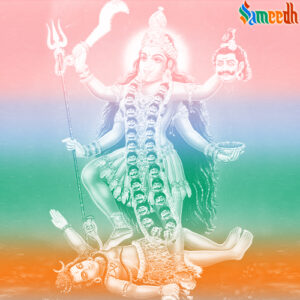Kali Puja, also known as Shyama Puja or Mahanisha Puja, is a Hindu festival dedicated to the worship of Goddess Kali, the fierce and powerful form of Devi (the Divine Mother). It is primarily celebrated in the eastern regions of India, particularly in West Bengal, Assam, Odisha, and Bangladesh.

Kali Puja is typically celebrated on the new moon night of the Hindu lunar month of Kartik, which usually falls in October or November according to the Gregorian calendar. It coincides with the Diwali festival in some regions.
During Kali Puja, devotees worship Goddess Kali, who symbolizes destruction of evil forces, protection, and liberation. Kali is depicted with a fierce demeanor, wearing a garland of skulls and holding various weapons. She is often depicted standing or dancing over the body of Lord Shiv.
Devotees offer prayers, flowers, incense, and various offerings to Goddess Kali at temples and makeshift altars in homes. Special rituals such as the chanting of mantras, recitation of hymns, and the performance of aarti (ritual worship with lamps) are conducted to invoke the blessings of the Goddess.
In some regions, Kali Puja coincides with the harvest season, making it a time for farmers to express gratitude for a bountiful harvest and seek blessings for future prosperity. The festival is often associated with agricultural rituals and offerings to ensure agricultural success.
Kali Puja is often associated with Tantric practices and rituals due to the fierce and potent nature of Goddess Kali. Tantric practitioners may perform complex rituals involving yantras (sacred geometric diagrams), mudras (hand gestures), and other esoteric practices to connect with the divine energy of Kali.
The worship of Kali during Kali Puja represents the triumph of good over evil, light over darkness, and the destruction of ignorance. Devotees seek protection from negative energies and obstacles, as well as spiritual growth and liberation from worldly attachments.
Kali Puja is celebrated with great enthusiasm and fervor in many communities, with elaborate decorations, processions, cultural performances, and feasting. It is a time for families and communities to come together in celebration and devotion.
Overall, Kali Puja is a significant Hindu festival that honors the fierce and compassionate aspect of the Divine Mother, Goddess Kali, and is observed with reverence and joy by millions of devotees across India and beyond.
How To Perform Kali Pooja?
Kali Puja is a sacred Hindu ritual dedicated to the worship of Goddess Kali, the fierce and powerful aspect of the Divine Mother. Here is a general guide on how to perform Kali Puja:
- Preparation: Before starting the puja, clean the worship area thoroughly and decorate it with flowers, garlands, and other auspicious items. Place a picture or idol of Goddess Kali in the center of the altar.
- Invocation: Begin the puja by invoking the presence of Goddess Kali. Chanting of mantras such as “Om Aim Hreem Kleem Chamundaye Vichche” or any other Kali mantras is commonly done to invoke her divine energy.
- Offerings: Offer various items to the deity as a mark of respect and devotion. Traditional offerings include flowers, fruits, sweets, coconuts, incense, betel leaves, and vermilion. You can also offer water, milk, honey, and other sacred substances.
- Lighting of Lamp: Light a lamp (diya) using ghee or oil, symbolizing the presence of divine light and dispelling darkness. Offer the light to the deity while chanting prayers or mantras.
- Prayers and Chanting: Recite prayers, hymns, or mantras dedicated to Goddess Kali. You can chant Kali Chalisa, Kali Sahasranama, or other devotional songs praising the qualities and powers of the goddess.
- Arati: Perform the arati (ritual of waving a lit lamp) in front of the deity, moving it in a circular motion to illuminate the entire idol or picture of Goddess Kali. Sing arati songs praising the goddess’s glory and victory.
- Offering Bhog: Offer cooked food (bhog) to Goddess Kali as prasad (blessed food). This can include traditional dishes such as rice, lentils, vegetables, sweets, and fruits. After offering, distribute the prasad among devotees as a symbol of blessings from the goddess.
- Prayer and Meditation: Spend some time in prayer and meditation, expressing gratitude to Goddess Kali for her blessings, protection, and guidance in life. Reflect on her divine qualities and seek her continued presence and grace.
- Conclusion: Conclude the puja by seeking the blessings of Goddess Kali for health, prosperity, and spiritual growth. Offer a final arati to the deity and express gratitude for her divine presence during the worship.
- Distribution of Prasad: Distribute prasad to family members, friends, and devotees present during the puja. It is considered auspicious to share the blessings received from the goddess with others.
- Cleanup: After the puja, clean the worship area and dispose of any leftover offerings in a respectful manner. Store sacred items properly for future use.
It’s essential to perform Kali Puja with sincerity, devotion, and purity of heart, seeking the blessings and grace of Goddess Kali for protection, prosperity, and spiritual well-being. If you’re unsure about specific rituals or mantras, you can consult with a priest or seek guidance from reliable sources.
